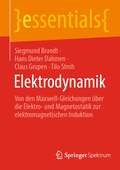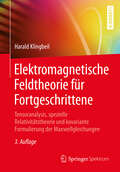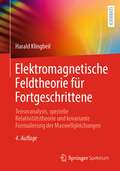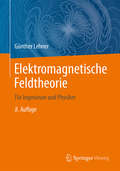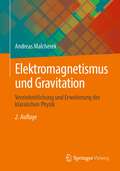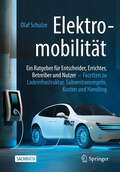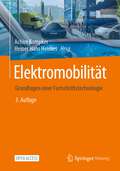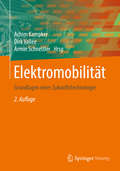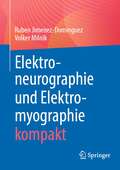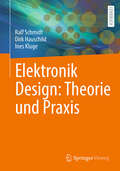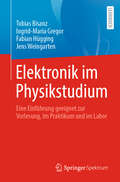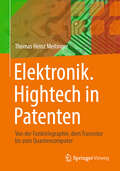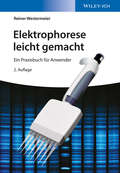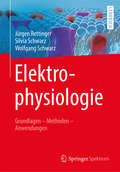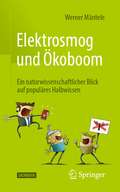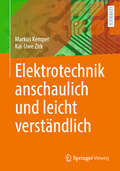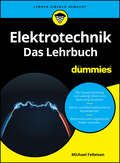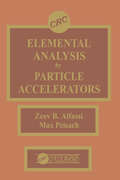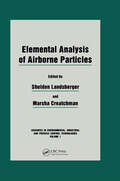- Table View
- List View
Elektrodynamik: Von den Maxwell-Gleichungen über die Elektro- und Magnetostatik zur elektromagnetischen Induktion (essentials)
by Hans Dieter Dahmen Siegmund Brandt Claus Grupen Tilo StrohDieses essential konzentriert sich auf die Vermittlung der wichtigsten Grundbegriffe, von der Elektrostatik, den Phänomenen des elektrischen Stromes bis hin zu den Maxwell-Gleichungen und aus ihnen abgeleiteten Erkenntnissen. Begriffe wie Ladung, Coulomb-Kraft, Dipol, elektrisches Feld und Potential, magnetisches Feld, Lorentz-Kraft und die Wechselbeziehungen zwischen elektrischen und magnetischen Feldern wie die Induktion werden dargestellt. Auf die vielen Anwendungen der Elektrodynamik wird hingewiesen.
Elektromagnetische Feldtheorie für Fortgeschrittene: Tensoranalysis, spezielle Relativitätstheorie und kovariante Formulierung der Maxwellgleichungen
by Harald KlingbeilDieses Buch bietet einen behutsamen Einstieg in die Tensoranalysis, in die Grundlagen der speziellen Relativitätstheorie und in die relativistische Formulierung der Elektrodynamik. Die Maxwell’schen Gleichungen im Vakuum und die kovariante Form der Maxwellgleichungen werden intensiv behandelt. Auch Dipole und die Abstrahlung elektromagnetischer Wellen bilden inhaltliche Schwerpunkte.Mathematisch präzise und durch ausführliche Rechnungen leicht verständlich, stellt das Buch eine Verbindung zwischen Elektrotechnik, Mathematik und Physik her. Für diesen Vertiefungsband ist ein Grundwissen der Elektrodynamik hilfreich, wie es im Band „Grundlagen der elektromagnetischen Feldtheorie — Maxwellgleichungen, Lösungsmethoden und Anwendungen“ des Autors oder vergleichbaren Lehrbüchern vermittelt wird.Übungsaufgaben mit ausführlichen Musterlösungen vertiefen den Stoff und helfen bei der Kontrolle des Lernerfolgs. Ein umfangreicher Tabellenteil am Ende des Buchs erlaubt die Nutzung als Nachschlagewerk.
Elektromagnetische Feldtheorie für Fortgeschrittene: Tensoranalysis, spezielle Relativitätstheorie und kovariante Formulierung der Maxwellgleichungen
by Harald KlingbeilDieses Buch bietet einen behutsamen Einstieg in die Tensoranalysis, in die Grundlagen der speziellen Relativitätstheorie und in die relativistische Formulierung der Elektrodynamik. Die Maxwell’schen Gleichungen im Vakuum und die kovariante Form der Maxwellgleichungen werden intensiv behandelt. Auch Dipole und die Abstrahlung elektromagnetischer Wellen bilden inhaltliche Schwerpunkte.Mathematisch präzise und durch ausführliche Rechnungen leicht verständlich, stellt das Buch eine Verbindung zwischen Elektrotechnik, Mathematik und Physik her. Für diesen Vertiefungsband ist ein Grundwissen der Elektrodynamik hilfreich, wie es im Band „Grundlagen der elektromagnetischen Feldtheorie — Maxwellgleichungen, Lösungsmethoden und Anwendungen“ des Autors oder vergleichbaren Lehrbüchern vermittelt wird.Übungsaufgaben mit ausführlichen Musterlösungen vertiefen den Stoff und helfen bei der Kontrolle des Lernerfolgs. Ein umfangreicher Tabellenteil am Ende des Buchs erlaubt die Nutzung alsNachschlagewerk.In der vorliegenden vierten Auflage wurden zahlreiche Themen überarbeitet, neue hinzugefügt sowie an vielen Stellen kleinere Ergänzungen des Textes vorgenommen, um die Verständlichkeit weiter zu erhöhen und die Darstellung zu vervollständigen.
Elektromagnetische Feldtheorie: Für Ingenieure und Physiker
by Günther Lehner Stefan KurzDie elektromagnetische Feldtheorie ist ein für Ingenieure und Naturwissenschaftler grundlegendes Wissensgebiet, das die Gesetzmäßigkeiten elektrischer und magnetischer Felder und Wellen beschreibt. In diesem didaktisch ausgearbeiteten Lehrbuch werden die elektromagnetische Feldtheorie und die dafür erforderlichen mathematischen Methoden vermittelt. Dafür hat der Autor die Lehrinhalte möglichst anschaulich aufbereitet, die Begriffsbildungen und Ableitungen legt er äußerst genau dar.Zu Beginn werden die Maxwellschen Gleichungen, die die Grundlage der klassischen Elektrodynamik bilden, vorgestellt und erläutert. Es folgen Ausführungen über Elektrostatik, Strömungsprobleme, Magnetostatik, quasistationäre Felder und elektromagnetische Wellen. Der Autor behandelt die Anwendung numerischer Methoden wie finite Differenzen, finite Elemente (FEM), Randelemente, Ersatzladungsmethoden und Monte-Carlo-Methoden auf feldtheoretische Probleme. Darüber hinaus gibt er immer wieder Ausblicke auf grundlegende, zum Teil noch offene Fragen der Physik bis hin zur Quantenmechanik. Ein Kapitel widmet sich der Relativitätstheorie, die Maxwells klassische Elektrodynamik erweitert. Denn mithilfe von Einsteins Theorie lassen sich zahlreiche Probleme der elektromagnetischen Feldtheorie leichter lösen.Das Lehrbuch richtet sich an Studierende der ingenieurwissenschaftlichen Fächer und der Physik. Aber auch Studierende anderer naturwissenschaftlicher Fachrichtungen profitieren von diesem Standardwerk zur elektromagnetischen Feldtheorie. Ein Verzeichnis der Symbole und ein Sachverzeichnis erleichtern die Handhabung des Buchs und unterstützen das Lernen.
Elektromagnetische Feldtheorie: für Ingenieure und Physiker
by Günther Lehner Stefan KurzDie elektromagnetische Feldtheorie ist ein für Ingenieure und Naturwissenschaftler grundlegendes Wissensgebiet, das die Gesetzmäßigkeiten elektrischer und magnetischer Felder und Wellen beschreibt. In diesem didaktisch ausgearbeiteten Lehrbuch werden die elektromagnetische Feldtheorie und die dafür erforderlichen mathematischen Methoden vermittelt. Dafür hat der Autor die Lehrinhalte möglichst anschaulich aufbereitet, die Begriffsbildungen und Ableitungen legt er äußerst genau dar.Zu Beginn werden die Maxwellschen Gleichungen, die die Grundlage der klassischen Elektrodynamik bilden, vorgestellt und erläutert. Es folgen Ausführungen über Elektrostatik, Strömungsprobleme, Magnetostatik, quasistationäre Felder und elektromagnetische Wellen. Der Autor behandelt die Anwendung numerischer Methoden wie finite Differenzen, finite Elemente (FEM), Randelemente, Ersatzladungsmethoden und Monte-Carlo-Methoden auf feldtheoretische Probleme. Darüber hinaus gibt er immer wieder Ausblicke auf grundlegende, zum Teil noch offene Fragen der Physik bis hin zur Quantenmechanik. Ein Kapitel widmet sich der Relativitätstheorie, die Maxwells klassische Elektrodynamik erweitert. Denn mithilfe von Einsteins Theorie lassen sich zahlreiche Probleme der elektromagnetischen Feldtheorie leichter lösen. Das Lehrbuch richtet sich an Studierende der ingenieurwissenschaftlichen Fächer und der Physik. Aber auch Studierende anderer naturwissenschaftlicher Fachrichtungen profitieren von diesem Standardwerk zur elektromagnetischen Feldtheorie. Ein Verzeichnis der Symbole und ein Sachverzeichnis erleichtern die Handhabung des Buchs und unterstützen das Lernen.
Elektromagnetismus und Gravitation: Die Vereinheitlichung der klassischen Physik
by Andreas MalcherekElektromagnetismus und Gravitation scheinen zwei vollkommen unterschiedliche Wechselwirkungen zu sein: Während elektromagnetische Wechselwirkungen durch Felder beschrieben werden, soll die Gravitation durch eine Krümmung der Raumzeit vermittelt werden. Die Theorie der Elektrogravitation vereinheitlicht die formale Beschreibung dieser beiden Wechselwirkungen. Damit stellt sich natürlich die grundlegende Frage, ob man aus einem einheitlichten Formalismus auch auf einheitliche Wirkmechanismen in der Natur schließen kann. Das Lehrbuch entwickelt die Theorie der Elektrogravitation aus einfachen Prinzipien der speziellen Relativitätstheorie. Darauf aufbauend werden das Newtonsche Gravitationsgesetz, das Coulombsche und das Biot-Savartsche Gesetz sowie die Maxwellschen Gleichungen hergeleitet.
Elektromagnetismus und Gravitation: Vereinheitlichung und Erweiterung der klassischen Physik
by Andreas MalcherekElektromagnetismus und Gravitation scheinen zwei vollkommen unterschiedliche Wechselwirkungen zu sein: Während elektromagnetische Wechselwirkungen durch Felder beschrieben werden, soll die Gravitation durch eine Krümmung der Raumzeit vermittelt werden. Die Theorie der Elektrogravitation vereinheitlicht die formale Beschreibung dieser beiden Wechselwirkungen. Damit stellt sich natürlich die grundlegende Frage, ob man aus einem einheitlichten Formalismus auch auf einheitliche Wirkmechanismen in der Natur schließen kann. Das Lehrbuch entwickelt die Theorie der Elektrogravitation aus einfachen Prinzipien der speziellen Relativitätstheorie. Darauf aufbauend werden allgemeine Gesetze für das Gravitationspotential und die Bewegung in demselben aufgestellt, die die Newtonsche Gravitationstheorie in Richtung allgemeiner Relativitätstheorie verallgemeinern. Mit den formal gleichen Ansätzen werden in der Elektrodynamik das Coulombsche Gesetz sowie die Maxwellschen Gleichungen hergeleitet. Abschließend werden retardierte Potentiale und die Grundlagen der Magnetohydrodynamik vermittelt.
Elektromobilität
by Achim Kampker Armin Schnettler Dirk ValléeDas Buch gibt einen umfassenden Überblick über die Herausforderungen und Lösungen zum Thema Elektromobilität. Von Gestaltungshinweisen bei der Konstruktion des Antriebsstrangs bis hin zu Ansätzen zum Aufbau der Infrastruktur wird ein breites Feld an Themen beleuchtet. Das Buch gliedert sich in fünf Kapitel. In einem Grundlagenkapitel werden die Herausforderungen der Elektromobilität sowie der Ansatz einer integrierten Produkt-, Prozess- und Infrastrukturentwicklung skizziert. Im Kapitel Elektromobilproduktion wird der Prozess der Industrialisierung eines Produktes und die Produktion der Antriebskomponenten dargestellt. Ansätze des Innovationsmanagements und das Thema wirtschaftlicher Leichtbau finden sich im Kapitel Automotive Engineering wieder. Das Kapitel Infrastruktur beinhaltet die Konzepte zum Aufbau eines Servicenetzes und beim Städtebau. Die notwendigen Rechtsgrundlagen und Strategien zur Geschäftsmodellentwicklung werden im Kapitel Business Conception erläutert.
Elektromobilität
by Markus LienkampDas wachsende Bedürfnis nach Mobilität in der Bevölkerung lässt sich auf Dauer nur durch den Einsatz elektrischer Klein- und Lieferfahrzeuge für Kurzstrecken befriedigen. Mobilitätsanbieter und Kunden müssen dabei gut vernetzt sein. Die allmähliche Marktdurchdringung der Elektromobilität ist eine große Herausforderung für die Automobilindustrie. Gewinner sind einige gut aufgestellte Automobilhersteller und ein Überraschungssieger. Da die Ölreserven der Erde endlich sind und der Ölpreis in Zukunft steigen dürfte, soll Strom als alternativer Kraftstoff eine Lösung des Problems liefern. Der Autor skizziert aus der Sicht eines Insiders, weshalb ein Wandel unabdingbar ist und beschreibt die notwendigen Schritte.
Elektromobilität – ein Ratgeber für Entscheider, Errichter, Betreiber und Nutzer: Facetten zu Ladeinfrastruktur, Subventionsregeln, Kosten und Handling
by Olaf SchulzeE-Mobilität ist komplex, alle Betroffenen haben gleichen Fragen. Das Buch soll Antworten geben auf die Entscheidung über die nötige und benötigte Ladeinfrastruktur von Ladetechnik, Netzanschluss, Handling, Kostenkalkulation, Nutzerverhalten, E- Fahrzeuge und deren netzdienliches Ladeverhalten, gesetzliche Regelungen für E-Mobilität und Operation, Abrechnung bis zu Webportalen. Es soll Entscheidungshinweise für verschiedene Stakeholder und Entscheiderebenen geben, natürlich auch Wirtschaftlichkeitserwägungen beschreiben. Das Sachbuch soll Trends, Unwägbarkeiten, Regulierungen und internationale Entwicklungen beinhalten und mit einem kritischen Selbstversuch- von der Anschaffung über das Fahren, Laden, App-Anwendungen abschließen. Leser sind Unternehmen, Organisationen und Privatleute, die E-Mobilität in Logistik, Belieferung, Transport und PKW einsetzen wollen.
Elektromobilität: Grundlagen einer Fortschrittstechnologie
by Achim Kampker Heiner Hans HeimesDieses Buch ist eine „Open Access“-Publikation zum Stand der Entwicklung der Elektromobilität. Ohne Zweifel: Die Automobilindustrie befindet sich in einem tiefgreifenden Wandel. Mit der Elektromobilität verändern sich bisherige Fahrzeug- und Antriebskonzepte grundlegend. Bestimmt durch neue Fahrzeugkomponenten wie die Batterie, die Leistungselektronik, der Elektromotor und die Brennstoffzelle, verändert sich der gesamte Wertschöpfungsprozess. Dieses Werk liefert einen umfassenden Überblick zu den Herausforderungen und Lösungen in sämtlichen Bereichen: von der Produktentwicklung über die Herstellung von Elektrofahrzeugen bis hin zum Aufbau einer Infrastruktur, zu neuartigen Geschäftsmodellen und den Potentialen der Nachhaltigkeit. Wie weit reicht die Geschichte der Elektromobilität zurück? Welche spezifischen Systeme finden sich im Elektromobil wieder und wie werden sie bis hin zum gesamten Fahrzeug hergestellt? Welchen technischen und gesetzlich-regulatorischen Rahmenbedingungen unterliegt die E-Mobilität? Wie ist es um die notwendige Infrastruktur bestellt? Welche neuen Geschäftsmodelle entstehen entlang der elektromobilen Wertschöpfungskette? Und wie nachhaltig ist die Elektromobilität tatsächlich? Antworten auf diese und andere Fragen liefert dieses Buch in sieben informativen Kapiteln. Für die dritte Auflage wurden sämtliche Inhalte neu strukturiert und auf den aktuellen Stand der technologischen Entwicklung gebracht.
Elektromobilität: Grundlagen einer Zukunftstechnologie
by Achim Kampker Armin Schnettler Dirk ValléeDie Automobilindustrie befindet sich in einem tiefgreifenden Wandel. Mit der Elektromobilität verändern sich bisherige Fahrzeug- und Antriebskonzepte grundlegend – und damit auch der gesamte Wertschöpfungsprozess. Das Buch liefert einen umfassenden Überblick über die Herausforderungen und die Lösungen zu allen Aspekten der Elektromobilität: von der Produktentwicklung über die Produktion von Elektrofahrzeugen mit Hinweisen für die Konstruktion des Antriebsstrangs bis hin zum Aufbau einer Infrastruktur und zu Geschäftsmodellen. Für die zweite Auflage wurden sämtliche Inhalte auf den aktuellen Stand der technologischen Entwicklung gebracht. Das Thema Batterieproduktion wurde ebenso erweitert wie die damit verknüpfte Frage des Remanufacturings als Teil des Recycling-Kreislaufes. Das Buch gliedert sich in fünf Kapitel. Im Grundlagenkapitel werden die Herausforderungen der Elektromobilität beschrieben und die Ansätze für eine integrierte Produkt-, Prozess- und Infrastrukturentwicklung skizziert. Darüber hinaus bietet es umfassende Einblicke in die Montage von Elektrofahrzeugen. In den folgenden Kapiteln werden Konzepte für den Städtebau und für den Aufbau eines Servicenetzes vorgestellt sowie Geschäftsmodelle, ihre Entwicklung und Rechtsgrundlagen erläutert. Im Kapitel Fahrzeugkonzeption geht es um den Prozess der Industrialisierung und Fragen der Batterieproduktion. Die Entwicklung von elektrofahrzeugspezifischen Komponenten wie der des Antriebsstrangs wird im abschließenden Kapitel „Entwicklung von elektrofahrzeugspezifischen Systemen“ beschrieben.
Elektroneurographie und Elektromyographie kompakt
by Ruben Jimenez-Dominguez Volker MilnikDer kompakte Taschenatlas stellt mithilfe von Flussdiagrammen und Fotos wesentliche Konzepte für die Durchführung, Interpretation und Befundung der Elektroneurographie und Elektromyographie dar, nützlich für alle in der Elektrophysiologie tätigen Ärzte und MTAs. Die neurophysiologische Diagnostik ist als verlängerter Arm der Anamnese und der klinischen Untersuchung ein bedeutender Bestandteil der Evaluation von Erkrankungen des peripheren Nervensystems. Dieses Buch bietet eine schnelle Übersicht mit den wichtigsten Tools für die Untersuchungen im elektrophysiologischen Labor.
Elektronik Design: Theorie und Praxis
by Ralf Schmidt Dirk Hauschild Ines KlugeDieses Buch gibt einen Überblick über die wichtigsten Bereiche zur Entwicklung und Konstruktion elektronischer Geräte, zusammengefasst unter dem Begriff Elektronik Design, und beginnt mit der Bereitstellung des Stromlaufplans.In zunehmendem Maße erfordert die Realisierung von Elektronik durch immer kleinere Bauelemente, die direkte Verarbeitung von Halbleiterchips, zunehmende Taktfrequenzen und Verlustleistungen interdisziplinäre Betrachtungen von Design, Technologien und Werkstoffen. Aus diesem Grund wurde den Darstellungen der Technologien größerer Raum gegeben.Die Kapitel sind so gestaltet, dass sie auch einzeln für sich gelesen werden können. Einige Inhalte sind in mehreren Kapiteln zu finden, da eindeutige Zuordnungen nicht immer möglich oder sinnvoll sind.
Elektronik im Physikstudium: Eine Einführung geeignet zur Vorlesung, im Praktikum und im Labor
by Tobias Bisanz Ingrid-Maria Gregor Fabian Hügging Jens WeingartenDieses Buch wendet sich an Studierende naturwissenschaftlicher Studiengänge und eignet sich als perfekter Begleiter für Vorlesungen und Praktika zu den Grundlagen der analogen und digitalen Elektronik. Der Inhalt entspricht einer typischen ein- bis zweisemestrigen Vorlesung in den physikalischen Studiengängen (z.B. Physik und Medizinphysik). Dabei werden keine Kenntnisse der höheren Mathematik oder komplexer Physik vorausgesetzt, so dass das Buch auch für Studierende anderer naturwissenschaftlicher Studiengänge zugänglich ist. Das didaktische Konzept und die klare Sprache helfen beim Verständnis und der Vertiefung des Stoffes. Der Aufbau folgt einer typischen Elektronik-Vorlesung von den Grundlagen wie Strom und Spannung über die wichtigsten Halbleiterbauelemente bis hin zu Grundlagen und Anwendungen der digitalen Elektronik. Abschließend wird als Beispiel für die Anwendung des erarbeiteten Verständnisses die elektronische Erfassung von Messwerten besprochen, wie sie sehr oft in der Laborpraxis naturwissenschaftlicher Berufe benutzt wird.
Elektronik. Hightech in Patenten: Von der Funktelegraphie, dem Transistor bis zum Quantencomputer
by Thomas Heinz MeitingerElektronische Schaltungen werden heutzutage zumeist aus kristallinen Halbleitern hergestellt, in die Fremdatome eingebracht werden (Dotierung). Die Anfänge der Elektronik kennzeichnen jedoch die Elektronenröhren, mit denen die ersten gleichrichtenden und schaltenden Funktionen verwirklicht wurden. Die ersten, auf dieser Technologie basierenden Computer hatten eine geringe Leistung, wiesen dennoch gewaltige räumliche Ausmaße auf. Erst mit der Verwendung von dotierten Halbleitern begann die Miniaturisierung und die dynamische Entwicklung der Elektronik. Dieses Buch zeigt die Entwicklung der hierfür erforderlichen Elektronik von der Analogtechnik mit den Operationsverstärkern über die Digitaltechnik, die letzten Endes ins Computerzeitalter geführt hat, und der Hochfrequenztechnik, die entscheidend die Nachrichtenübertragung bestimmt hat, bis hin zur Leistungselektronik, die eine elektrische Energieversorgung ermöglicht. In diesem Buch werden die hierfür benötigten Erfindungen und die resultierende technische Entwicklung anhand der Hauptansprüche und Zeichnungen aus Patentschriften vorgestellt.
Elektrophorese leicht gemacht: Ein Praxisbuch für Anwender
by Reiner WestermeierDie zweite Auflage eines Standardwerks: Alle wichtigen Aspekte und Techniken der Elektrophorese werden abgedeckt, von SDS-PAGE und Isotachophorese bis zu isoelektrischer Fokussierung, blauer Nativ-Elektrophorese und zweidimensionalen Methoden. Speziell auf die Bedurfnisse von Laboranten und technischen Angestellten zugeschnitten, stehen praktische Gesichtspunkte und Methoden im Mittelpunkt des Buchs. Nach einem Uberblick uber alle gangigen Elektrophoresetechniken mit einer Einfuhrung in Detektion, Musterauswertung und Proteomik folgen Kapitel zu Instrumentierung und benotigten Arbeitsmaterialien. Detaillierte Methodenanleitungen erleichtern auch dem Anfanger den praktischen Einstieg in die Welt der Elektrophorese. Die Begleitwebsite mit zahlreichen Animationen ermoglicht einen zusatzlichen visuellen Zugang zu den einzelnen Techniken.
Elektrophysiologie: Grundlagen - Methoden - Anwendungen
by Wolfgang Schwarz Jürgen Rettinger Silvia SchwarzDieses Lehrbuch bietet einen umfassenden Überblick zur zellulären Elektrophysiologie. Die Themen reichen von bioelektrischen Phänomenen, die schon im antiken Ägypten beschrieben wurden, bis hin zu aktuellen Streitfragen wie der Gefahr durch Elektrosmog. Dieses kurz und prägnant geschriebene Werk beschreibt wissenschaftlich präzise verschiedene Methoden und Anwendungen der Elektrophysiologie sowie die biophysiologischen Grundlagen von Ionenkanälen und Carrier-Proteinen. Zahlreiche sorgsam ausgewählte Illustrationen und Grafiken ergänzen das Geschriebene, während Fragen am Ende jedes Kapitels dem Leser die Möglichkeit zur Selbstkontrolle bieten. Jeder Abschnitt enthält zudem Verweise auf relevante Publikationen und Literaturstellen, die für ein tieferes Verständnis zu Rate gezogen werden können. Das Buch stellt somit eine wertvolle Informationsquelle für Studierende der Biologie, Chemie und Physik dar, die sich speziell für Biophysik interessieren.
Elektrosmog und Ökoboom: Ein naturwissenschaftlicher Blick auf populäres Halbwissen
by Werner MänteleWas ist wirklich dran an den Gefahren durch Elektrosmog, Gentechnik und Radioaktivität? Sind die Risiken durch Feinstaub und Stickoxide in unseren Städten tatsächlich so groß, wie oft behauptet wird? Gibt es Gründe zu glauben, dass Funkmasten und Hochspannungsleitungen unsere Gesundheit gefährden? Und ist „Öko…” automatisch immer gut? Dieses Buch geht solchen Fragen mit einer soliden wissenschaftlichen Arbeitsweise nach. Es hilft Ihnen dabei, den Hintergrund der befürchteten Risiken zu verstehen und mögliche Gefahren, aber auch Chancen richtig einzuordnen. Von der Mobiltelefonie über die Energiewende bis zur Gentechnik behandelt das Buch Themen, die in unserer Gesellschaft sehr kontrovers und teilweise emotional diskutiert werden. Der Autor führt Sie kurzweilig durch die wissenschaftlichen Grundlagen und klärt Sie mit Augenzwinkern über populäre Irrtümer und Fehlvorstellungen auf. Er zeigt Ihnen, wie Sie in Medien oder im Internet Quellen für solide Informationen finden, denen Sie vertrauen können und die nicht von Ideologien geprägt sind. So ermöglicht die Lektüre des Buches Ihnen ein eigenes, wissenschaftlich begründetes Urteil.
Elektrotechnik anschaulich und leicht verständlich
by Markus Kemper Kai-Uwe ZirkDas Buch vermittelt ein grundlegendes Verständnis der Elektrotechnik anhand von Beispielen des alltäglichen Lebens und deren physikalischer Systeme. Daher werden häufig zu Beginn eines Abschnitts die Grundlagen anhand einführender Beispiele mit entsprechend notwendiger didaktischer Reduktion beschrieben. Mathematische Herleitungen werden nur an Stellen, an denen diese unbedingt notwendig sind, aufgeführt. Grundsätzlich wird eine anschauliche und möglichst einfache Darstellung verwendet. Ziel dieses Buches ist, nach einer verständlichen Einführung, die richtige wissenschaftliche Darstellung aufzuführen und dem Lesenden einen möglichst einfachen Zugang in die Elektrotechnik zu geben. Es richtet sich somit insbesondere an Studierende oder Studieninteressierte, die sich einen Einblick in die Elektrotechnik verschaffen wollen.
Elektrotechnik für Dummies. Das Lehrbuch (Für Dummies)
by Michael FelleisenElektrotechnik ohne Schnick, nur mit (ein wenig) Schnack Michael Felleisen erläutert in diesem Buch, was Sie über Stromkreise und Widerstände, elektrische Felder und Kondensatoren wissen müssen. Weiter erklärt er Ihnen, was es mit der Wechselstromtechnik, magnetischen Feldern und Spulen auf sich hat. Auch nicht zu kurz kommen Frequenzgang, Ortskurve, Filterschaltungen und Dreiphasen-Wechselstromsysteme. Mit Übungsaufgaben und ausführlichen Lösungen können Sie Ihr Wissen überprüfen und festigen. So ist dieses Buch eine umfangreiche Einführung in die Elektrotechnik und Ihr freundlicher Begleiter durch das Studium. Sie erfahren Wie Ladung, Strom und Spannung zusammenhängen Wie Sie Gleichstromkreise zeichnen und wie diese wirken Was es mit Flussdichte und Dielektrizitätskonstante auf sich hat Was es über Wechselstromkreise zu wissen gibt
Elektrotechnik und Elektronik: Für Maschinenbauer und Verfahrenstechniker
by Michael Beck Rudolf BuschDieses Lehrbuch legt neben einer anschaulichen Darstellung der Grundlagen von elektrischen und magnetischen Feldern und Stromkreisen den Schwerpunkt auf die Anwendungen in Elektronik, elektrischen Maschinen, Energieversorgung und Messtechnik. Dabei gibt es zu jedem Kapitel Übungsaufgaben unterschiedlichen Schwierigkeitsgrades, um das Erlernte zu prüfen und zu festigen. Die vorliegende 8. Auflage wurde auf den aktuellen Stand der Technik gebracht. Das trifft insbesondere auf den Teil B zu (Anwendungen der Elektrotechnik). Im Vordergrund stehen dabei Elektronik und elektrische Messtechnik sowie der Asynchronmotor in seiner Anwendung in geregelten elektrischen Antrieben. Im Zusammenhang mit der breiteren Nutzung erneuerbarer Energien werden die verwendeten Techniken und Technologien beschrieben.
Element Analysis of Biological Samples: Principles and Practices, Volume II
by K. S. Subramanian G. Venkatesh Iyengar Joost R.W. WoittiezDespite the development of innovative new analytical techniques for biological trace element research, today's trace element investigators face formidable obstacles to obtaining reliable data. This complete reference identifies and assesses the challenges the analyst encounters at each stage of an analysis, and discusses the effects of various techniques on the sample.Three internationally recognized scientists and authors consider the effects of the numerous collection, storage, and sample preparatory techniques used in sample analysis. Proper analytical quality control, including such critical factors as sampling and sample preparation, specimen preservation and storage, and ashing, is examined. The book also looks at sample preparation methods unique to various instruments and speciation chemistry issues, and examines the link between chemical analysis and specimen banking. A previously unrecognized source of error, presampling factors, is also discussed.
Elemental Analysis by Particle Accelerators
by Zeev Alfassi Max PeisachElemental Analysis by Particle Accelerators describes the theory, methodology, and applications for a wide variety of sensitive, non-destructive methods of analysis capable of both high selectivity and multielemental determinations. Specific methods discussed include radioactive methods, particle backscatter analysis, recoil techniques, and nuclear reaction analysis. The use of multielemental PIXE and PIGME analyses of "real world" thick samples in environmental studies, trace element applications in biology, and provenance studies in archaeology are also covered. The book is a useful reference for practicing specialists and an essential text for students.
Elemental Analysis of Airborne Particles
by Sheldon Landsberger Marsha CreatchmanAn increased standard of living in developed and developing countries has brought about a distinct rise in pollution. The problem of air pollution has specifically increased the public's awareness of the environmental and health-related consequences resulting from modern day industrial technology. This detailed collection of works devoted to the most popular methods in elemental analysis of airborne particles offers investigators a comprehensive book on the most common laboratory analytical methods currently used in trace element analysis. Discussed are atomic absorption spectrometry, inductively coupled plasma, atomic emission, particle induced gamma ray analysis, particle elastic scattering and Rutherford backscattering, and neutron activation analysis. Specific sections on quality assurance/quality control and source receptor modeling have also been included.
